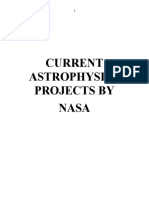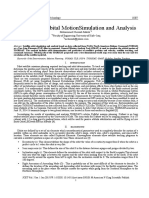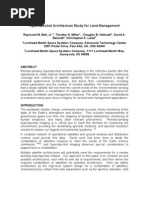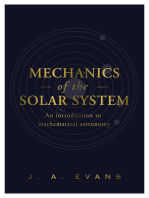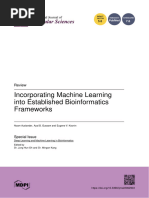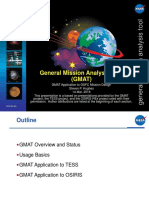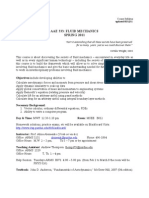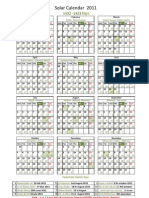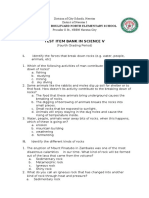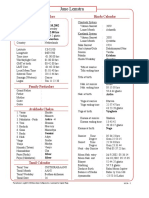Earth-Tide As Parameter of Crustal Motion Correction For SLR Station Displacement
Earth-Tide As Parameter of Crustal Motion Correction For SLR Station Displacement
Uploaded by
Francisco CarvalhoCopyright:
Available Formats
Earth-Tide As Parameter of Crustal Motion Correction For SLR Station Displacement
Earth-Tide As Parameter of Crustal Motion Correction For SLR Station Displacement
Uploaded by
Francisco CarvalhoOriginal Title
Copyright
Available Formats
Share this document
Did you find this document useful?
Is this content inappropriate?
Copyright:
Available Formats
Earth-Tide As Parameter of Crustal Motion Correction For SLR Station Displacement
Earth-Tide As Parameter of Crustal Motion Correction For SLR Station Displacement
Uploaded by
Francisco CarvalhoCopyright:
Available Formats
LUDWIG COMBRINCK AND VASYL SUBERLAK 203
Earth-tide as parameter of crustal motion correction
for SLR station displacement
Ludwig Combrinck and Vasyl Suberlak
Space Geodesy Programme, HartRAO, PO. Box 443, Krugersdorp, 1740, South Africa
e-mail:ludwig@hartrao.ac.za; vasyl@hartrao.ac.za
© 2007 September Geological Society of South Africa
ABSTRACT
A new Satellite Laser Ranging (SLR) analysis program is being developed at Hartebeesthoek Radio Astronomy
Observatory (HartRAO) that can model satellite orbits with high accuracy utilising advanced modelling and SLR data.
We introduce the background to SLR analysis to an interdisciplinary audience and present the results of processing
one month of LAGEOS-1 and LAGEOS-2 data in combined and separate solutions. The inclusion of Earth-tide
modelling is shown to be necessary to reduce range bias and to minimise observed minus computed (O-C) residuals.
The combined solution shows a reduction in range bias when allowance is made for the SLR station displacement
vector due to solid Earth-tide and the effect of the Earth-tide on the static gravity field. In order to make the
comparison it is necessary to set the a-priori estimation error of unmodelled forces to a low value as it tends to absorb
range biases and improve O-C residuals if included as an additional solve-for parameter. A comparison between the
SLR station position perturbation resulting from solid Earth-tide and range bias indicates a correlation, which probably
results from an overestimate of the Earth-tide vector and indicates that SLR will be able to differentiate between and
evaluate different Earth-tide models. These are preliminary results and further improvement is envisaged due to the
planned inclusion of additional advanced modelling procedures. Applications of this software will include velocity
field determinations for crustal dynamics studies.
Introduction using these data. These include the realisation,
The Space Geodesy Programme of HartRAO produces maintenance, and improvement of the International
data that are multi-disciplinary in nature and are used Terrestrial Reference Frame (ITRF) and monitoring the
in diverse research topics such as geophysics, plate 3-dimensional deformation of the solid Earth.
tectonics, neotectonics, gravity, oceanography, SLR is a space geodetic technique whereby a short
meteorology, space science and fundamental physics. laser pulse is transmitted to a satellite equipped with a
Within the framework of Inkaba yeAfrica, the research suitable corner cube reflector that reflects the incoming
initiative proposed by HartRAO reflects the objectives of laser light back to the SLR. A telescope (part of the SLR
a multi-disciplinary, long-term earth science project with system) collects the returning photons and by utilising a
special emphasis on multi-techniques and capacity precise clock, the round-trip time from pulse
building in the southern Africa region. transmission to pulse reception can be determined.
A multitude of forces continuously act upon the solid Several satellites have been launched for specific
Earth. External forces result from the gravitational geodetic objectives such as LAGEOS-1 and LAGEOS-2
attraction of the Sun, Moon, and planets. Surface forces (LAser GEOdynamics Satellite). These satellites have a
are due to the action of the atmosphere and oceans. small area-to-mass ratio which minimizes the effects of
Internal forces are due to mantle convection, tectonic non-gravitational forces such as experienced from solar
motions and coupling between the mantle and both the pressure. SLR accuracy and orbit determination
fluid outer core and the solid inner core. The solid Earth techniques can fit a three-day arc of LAGEOS data to a
reacts to these forces by undergoing rotational precision of 1 to 2 cms. LAGEOS-1 was launched on
accelerations, mass displacements, and continuous May 4, 1976 and LAGEOS-2 on October 22, 1992. Both
deformation, which in turn affects the position of a satellites have a diameter of 60 cm and are spherical in
space geodetic system located on the surface of the shape; their surfaces are covered with 426 corner cube
Earth. This paper will address and quantify the effect reflectors.
that non-inclusion of station displacement due to the
solid Earth-tide has on the O-C residuals and range bias SLR analysis program
for a selected station (Yarragadee, 7090). Currently we are developing an SLR analysis program
The present lunar and artificial satellite laser ranging that processes normal point data (data that are generated
(LLR/SLR) tracking network, through the aegis of the from raw data to statistically improve its accuracy). Data
International Laser Ranging Service (ILRS), is responsible are obtained by ILRS SLR stations; see for instance
for monitoring an increasingly large number of Earth- Pearlman et al. (2002).
orbiting satellites. HartRAO supports the ILRS through One of the objectives of the SLR analysis program is
operating MOBLAS6 as part of the NASA SLR network. to determine an accurate position of the centre of mass
A host of scientific disciplines are being investigated of the satellite tracked by SLR at the epoch of the normal
SOUTH AFRICAN JOURNAL OF GEOLOGY, 2007, VOLUME 110 PAGE 203-210
doi:10.2113/gssajg.110.2/3.203
204 SATELLITE LASER RANGING AND CRUSTAL MOTION
point derived from SLR data. Using these positions, the use a concentric annulus model developed to improve
orbit or orbital arcs can be determined or improved. solar radiation modelling. The complexity of the model
Once an accurate orbit has been determined, a strategy can be pre-set; for this work the satellite was modelled
can be developed to determine certain parameters such by using ten concentric bands to better approximate the
as the position of the SLR station or over a longer time spherical shape of the satellite instead of using a flat
period (2+ years) the velocity of the SLR station. Other plane for the area projected towards the Sun.
parameters can also be solved for, including the Varying incident angle compensation improves
coefficient of reflection or atmospheric drag. The station the determination of the coefficient of reflection of the
positions are expressed in an appropriate Earth-fixed satellite (LAGEOS-1 and -2 = 1.12).
reference frame such as the International Terrestrial
Reference Frame (ITRF) and earth orientation Corrections to SLR range measurements
parameters used for necessary transformations are The two-way range (uplink and downlink) is based on
provided by the International Earth Rotation Service the time-of-flight principle and is computed using an
(IERS). iterative procedure to determine the surface time of
arrival. Range bias results from the sum of all systematic
Several forces need to be taken into account when instrumental deviations and environmental errors
determining the orbit of the satellite. (Schillak, 2004) and needs to be taken into account.
The range bias is calculated by taking the average of the
The gravitational forces perturbing the orbit of the O-C residuals, the range bias is then re-introduced into
satellite consist of: the least-squares algorithm for orbit calculations as an
• Earth’s geopotential additional correction and a complete re-adjustment is
• Solid earth tides made. Different strategies exist to solve for range bias
• Ocean tides and its accuracy is affected by the quality of the orbit
• Planetary third-body perturbations (Sun, Moon and determination and the quantity and quality of the normal
planets) points used for the orbit calculation.
• Relativistic accelerations At optical wavelengths the troposphere is dispersive
• Atmospheric tide and a correction for an additional delay due to the
The non-gravitational forces consist of: troposphere must be made. An often-used correction for
• Atmospheric drag atmospheric delay is given by Marini and Murray (1973).
• Solar radiation pressure The HartRAO software utilises a modification of this
• Earth radiation pressure approach as implemented by Mendes et al. (2002),
• Thermal radiation acceleration which implements newly derived mapping functions for
optical wavelengths, using a large database of ray
Perturbed equations of motion tracing radiosonde profiles. These functions are
The satellite equations of motion can be expressed as optimised for a wavelength of 0.532 m and are valid
(Tapley et al. 2004) for elevation angles greater than three degrees, if one
neglects the contribution of horizontal refractivity
gradients. Typical SLR data processing rejects data
captured below 20 degrees and our software makes
provision for a variable setting for rejection of data
where r is the position vector of the satellite below any selected elevation setting. These corrections
=G(M1+M2 )~ =GM1 (G is the gravitational constant M1 and can be several metres and the delay is dependent on the
M2 are the masses of the Earth and satellite respectively), wavelength of the laser signal.
r is the distance between the satellite and the earth Additional corrections could be necessary to refer the
centre of mass. The orbit is constantly perturbed by SLR system to a benchmark tied to bedrock; this is
force (centre of mass), normally added as an offset. Some systems with X-Y
mounts where the axes intersect may not require such
an offset correction. In addition, technique dependent
systematic errors that are linked to the hardware and
software of the SLR system will affect the range bias.
where fNS is the contribution of the mass distribution of
the Earth, f3B is the perturbing force contribution from Coordinate and reference system
the Sun, Moon and planets, fg represents contributions The station coordinates and the initial coordinates of the
resulting from general relativity, fDRAG is the negative satellites are ITRF coordinates and the satellite a-priori
acceleration caused by atmospheric drag, fSRP represents coordinates are provided by the ILRS in the consolidated
the solar radiation force contribution, fERP the Earth prediction format (CPF). During processing, both
radiation pressure and fOther the forces that are not satellite and SLR station position vectors are transformed
modelled. The modelling of these forces will not be to a non-rotating (inertial) frame, the International
described here in more detail. For LAGEOS satellites we Celestial Reference Frame (ICRF).
SOUTH AFRICAN JOURNAL OF GEOLOGY
LUDWIG COMBRINCK AND VASYL SUBERLAK 205
The ICRF is a geocentric inertial coordinate system, the model of Mathews, Dehant and Gipson (1997).
defined by the mean equator and vernal equinox at The computation of Earth-tide and Ocean-tide loading
Julian epoch 2000.0 and is termed the J2000 system. (which affects the station position by 1-2 cm, a factor of
To account for the gravitational perturbations on the ten less than Earth-tide) is quite complex and we will
satellite orbit by the Sun, Moon and planets, we utilise only give a brief description here of the gravitational
the Jet Propulsion Laboratory (JPL) DE-405 planetary potential.
ephemeris (Standish, 1998), which is based on the ICRF The gravitational field of the Moon or Sun which has
inertial coordinate system. These coordinates have been mass M implies that at point P on the surface of the
converted from barycentric inertial to geocentric inertial. Earth a potential U exists, where
The SLR station coordinates are transformed to the ICRF
reference frame by taking into account polar motion
of the Earth, precession and nutation, and UT1
transformation. These data are obtained from the
International Earth Rotation Service (IERS) and we utilise Here R is the geocentric coordinates of P and s is
Bulletin B, with all values interpolated via polynomial those of the tide generating body, d is the distance of P
fits to the epoch of SLR measurement. The software to an axis through the system’s centre of mass and n the
conforms to the IERS96 conventions as far as precession mean motion of the body about this axis. Following
and nutation of the Earth’s polar motion is concerned Montenbruck and Gill (2000), the denominator of the
which specifies the 1976 International Astronomical expression describing U can be expanded to
Union (IAU) precession (Lieske et al., 1977;
Lieske, 1979) and the 1980 IAU nutation formula (Wahr,
1981; Seidelmann, 1982). An additional correction is
added which is derived from VLBI analysis (Herring et al.,
1991). UT1-UTC values are as provided by IERS
Bulletin B. as s >> R for the Sun and the Moon. The angle between
s and R is ␥. The distance of the point P to the axis
Earth tide effects on station position and variations through the system’s centre of mass can be written as
of the static gravity field
The SLR station position is continuously disturbed by
variations in the position of the Earth’s crust due to
horizontal and vertical displacements caused by tidal
perturbations and tectonic plate velocity. Tectonic plate
motion can be taken into account by calculating the Here dc = Ms/(M+M ) describes the geocentric distance
plate velocity using ITRF station velocities and adjusting of the centre of mass of the system where is the
the station position in the ITRF to the epoch of the SLR geocentric latitude of the centre of mass. The difference
observations. The gravitation of the Sun and Moon of the East longitudes of P and the perturbing body is
exerts a force on the Earth, which leads to a time-varying given by ⌬. Using the relation n2s3 = G(M+M ) (see
deformation of the Earth. These small periodic Bertotti and Farinella, 1990), the potential can be written
deformations of the Earth are termed solid Earth tides, as
with amplitudes ranging up to 35 cm. These Earth-tides
consequently affect the gravity field of the Earth, which
in turn affects the motion of the satellites.
We are utilising the Sotid library (Petrov, 2005) in our
software for computing station displacements due to
solid Earth-tides. This library uses the frequency domain The third term adds a small permanent equatorial bulge
approach and the HW95 (Hartmann and Wenzel, 1995) to the Earth that is smaller than that due to the rotation
expansion of the tide-generating potential. Love number of the Earth as n2 = 2 . The first term is constant
hnm and Shida number lnm characterise site displacements whereas the second term (U2) is a second-order zonal
caused by tides of spherical harmonic degree and order harmonic whose amplitude is proportional to GM/s3 so
nm. The Love number is related to vertical displacement that the tides due to the Moon are about twice as strong
and the Shida number to horizontal displacement. as those due to the Sun. This tidal potential basically
All generalised Love numbers of the second degree were describes an elastic deformation of the Earth. Deviations
used. The Sotid library supports several Love number from this simplistic elastic response are a result of
models of which we used the model of P. Mathews friction (which causes phase lags of the tidal bulge
submitted to IERS Conventions, 2000, revision of relative to the position of the Sun and Moon) and the
2001.10.10 as implemented by Petrov (2005). All orders rate-dependent behaviour of the Earth’s oceans.
of tidal waves of the second degree were taken into The tidal-induced gravity potential has many different
account, i.e. a combination of zonal, diurnal and semi- periods as the angle ␥ varies as the position of the Sun
diurnal orders. Third degree tides were included using and Moon changes with respect to the rotating Earth.
SOUTH AFRICAN JOURNAL OF GEOLOGY
206 SATELLITE LASER RANGING AND CRUSTAL MOTION
Figure 1. Range bias for the combined solution of LAGEOS-1 and LAGEOS-2 indicating a reduction in range bias as a result of including
Earth-tide modelling. Perturbations due to Earth-tide effects on the static gravity field was disabled.
Changes in the eccentricity of the orbits of the Sun and in our software application. The acceleration caused by
Moon result in monthly and annual periods. Detailed solid Earth tides when considered as an indirect
information concerning the calculation of station gravitational effect of the Sun and Moon can also
displacement due to the solid Earth tide can be found in conveniently be calculated as (Rizos and Stolz, 1985)
IERS (2003).
In addition to the station position variation caused by
the solid Earth tide, this tide (as well as the ocean and ,
pole tides) causes a change in the Earth’s gravitational
potential and therefore adds to the accelerations acting where md is the mass of the disturbing body
on the satellite. The Earth’s gravity field is therefore not (Sun, Moon), → rd the geocentric position vector of the
static, but contains small periodic variations, which will disturbing body, the angle between the geocentric
affect the motion of the satellites. These perturbations vector →r and → rd, and k2 is the Love number which
can be derived using an expansion of the tidal-induced describes the elasticity of the Earth’s body (0.299). For
gravity potential utilising spherical harmonics in an more accurate solutions (especially when low Earth
analogous way as for the previously discussed static orbiters are involved) the recommendations of the IERS
gravity field. Detailed descriptions of the calculations of (2003) will be more appropriate.
the variations in the standard geopotential coefficients
Cnm and Snm due to solid Earth tide; solid Pole tide and Ocean loading effects on station position and
the effect of the ocean tides can be found in IERS (2003). variations of the static gravity field
For practical purposes (Montenbruck and Gill, 2000) Ocean tide loading deforms the Earth’s crust due to the
these corrections to the unnormalized geopotential additional weight of the ocean tides. This deformation
coefficients can be calculated using leads to three dimensional station position variations.
Similar to Earth-tide the ocean tides are caused by the
gravitational pull of the Sun and Moon so that in effect
the ocean tides can be described as a sum of several
ocean tides of different periods. Typically the
11 harmonics with the largest amplitudes are used to
for the Sun and Moon respectively. Here kn are the Love compute the ocean tide loading. The amplitudes of the
numbers of degree n. The Earth-fixed latitude and ocean loading tides as they affect the station position
longitude of the disturbing body are given by and and the static gravity field are about one order of
respectively. This acceleration of the satellite decreases magnitude smaller than those of the solid Earth tides.
with 1/r4 and is especially important for low earth In our calculations during this work for the SLR station
orbiters. For the case of LAGEOS in our calculations Yarragadee in Australia, typical ocean loading site
during this work the accelerations were of the order displacement vectors are between 2 and 14 mm.
10-8. The contribution by ocean tides is about one order The software uses coefficients computed according
of magnitude smaller and at this stage is not considered to Scherneck (1991). These are available from
SOUTH AFRICAN JOURNAL OF GEOLOGY
LUDWIG COMBRINCK AND VASYL SUBERLAK 207
Table 1. lists the analysis strategy, conventions and programme settings that were adopted:
Celestial reference frame J2000
Terrestrial reference frame: ITRF2000 epoch 1997.0
Solar, lunar and planetary ephemerides for
3rd body gravitational perturbation JPL DE405 (Standish, 1998.)
Pole-tide correction (station position) IERS 2003
Pole-tide acceleration of satellite Not implemented
Relativity (space-time curvature) IERS 2003
Earth–tide correction (station position) Petrov 2005
Earth-tide acceleration of satellite (Rizos and Stolz, 1985)
Ocean loading correction (station position) Scherneck, 1991
Atmospheric loading Not implemented
Definition of origin Geocentric
Gravity model JGM-3 (20x20) (Tapley et al.1996)
LAGEOS-2 model Concentric annulus x 10
Reference epoch 1997.0
Tectonic plate model ITRF2000 velocity field
Earth orientation a-priori Earth orientation parameters and UTC-UT1 values as per IERS Bulletin B
extrapolated to observation epoch
A priori precession model IAU(1976) (Lieske, 1976)
A priori nutation model IAU(1980) (Seidelmann, 1980) and dPsi and dEpsilon corrections (Herring et al. 1991) from
IERS Bulletin B
O-C outlier rejection > 1 sigma or 10 cm
Data rejection <10 degrees elevation
Range bias Enabled
Time bias Disabled
Satellite centre-of-mass 251 mm, ILRS standard value (Otsubo and Appleby, 2003)
Reference frames, constants and models used in the analysis of the SLR data.
http://www.oso.chalmers.se/loading. We use a recent standard geopotential coefficients can be found in
ocean tide map model (GOT00.2, a TOPEX/POSEIDON IERS (2003).
derived solution) by Ray (1999). GOT99.2b and
GOT00.2 are long wavelength adjustments of FES94.1 Observations and data analysis
(a pure hydrodynamic model tuned to fit tide Data from the Australian SLR station Yarragadee were
gauges globally) using TOPEX/POSEIDON data and are processed for the month of 1 to 30 December 2005.
given on a 0.5 by 0.5 degree grid. To compute the Due to the developmental stage of our software it was
three-dimensional SLR site displacement we follow IERS not feasible to process longer sets of data and one
(2003) recommendations. If ⌬c denotes the month is adequate to test the Earth-tide implementation.
displacement component (radial, west, south) at a time The Yarragadee station is the best in the SLR network as
t for a particular site, then (IERS, 2003) far as data quantity is concerned and continuously
provides high quality data. For the period processed
there were 1721 normal points available, slightly more
for LAGEOS-2 (891) than for LAGEOS-1 (830).
We decided to process both LAGEOS-1 and LAGEOS-2
with in a simultaneous solution yielding a combined RMS and
mean value for the O-C residuals as well as a combined
range bias determination. This means that two orbits are
solved for simultaneously, one for each satellite,
however the location where the solid Earth-tide affects
the station position (Yarragadee) is the same for each
satellite orbit. Combining the two orbital solutions
increases the available data and reduces biases that
where fj and uj depend on the lunar node’s longitude, j could result from a single orbit. Both satellites were also
is the tidal angular velocity, j the astronomical processed independently to evaluate their orbital
argument at time t = 0h. The amplitudes Ack and phases solutions for comparison purposes.
ck, 1≤ k ≤ 11 are taken from the GOT00.2 model. Data of one month were processed in steps of three-
Consequently we convert the radial, west and south day arcs, firstly with Earth-tide modelling enabled and
components of the displacement to ⌬x, ⌬y, ⌬z Earth secondly disabled. We disabled (by setting its a-priori
centred, Earth fixed components, which are then standard deviation to a very low value) a solve-for
added to the station position at the SLR measurement parameter, which models unknown perturbations due to
epoch. solar pressure acceleration. Small, unmodelled forces are
The effect of ocean tides on the static gravity field is typically accounted for using the concept of empirical
not yet implemented in our software, but complete accelerations (all models are limited by uncertainties
descriptions of their incorporation as variations in the arising from material properties, varying satellite
SOUTH AFRICAN JOURNAL OF GEOLOGY
208 SATELLITE LASER RANGING AND CRUSTAL MOTION
Figure 2. Position displacement of the SLR station Yarragadee (Australia)due to Earth-tide indicating diurnal sub-and longer periods due to
the gravitational potential of the Sun and Moon.
Figure 3. Range bias for the combined solution of LAGEOS-1 and LAGEOS-2 indicating a reduction in range bias as a result of including
Earth-tide modelling. The unmodelled acceleration component was constrained and perturbations due to Earth-tide effects on the static
gravity field were enabled.
orientations and surface temperatures), which can have parameter, as it comprises force model parameters that
the form (Montenbruck and Gill, 2000) are supposed to be uncertain but are not modelled in
the least-squares estimation. We assume that other
software, when estimating the effect of including Earth-
tide or when comparing between Earth-tide models will
This mismodelling occurs mainly at a frequency of one- have to give careful attention to the effect that empirical
cycle-per-revolution (1CPR). In the equation a 0 is a accelerations have on the orbit estimation. A better fit to
constant acceleration bias, with a1 and a2 being the 1CPR the data in the least-squares sense may not indicate that
coefficients and the true anomaly. an improvement in orbit has been found as the empirical
In our application, if this parameter is enabled, acceleration coefficients will adjust throughout the
comparison between Earth-tide on or off becomes very orbital fit process, leading to reduced range bias and
difficult, as the solve-for parameter tends to absorb the O-C residuals. All other settings in our tests remained the
additional range bias if Earth-tide corrections are same. Increasing the length from a short-arc (an orbital
disabled. When set to have very small a-priori estimated revolution to three days) to a long-arc solution (> three
error, this solve-for parameter then becomes a consider days), in general increases the errors in the calculated
SOUTH AFRICAN JOURNAL OF GEOLOGY
LUDWIG COMBRINCK AND VASYL SUBERLAK 209
Table 2. Summary of results listing the mean of the RMS values of the O-C residuals of three-day arcs and the mean of the range biases.
Solution (Earth-tide variation of gravity field disabled) O-C (mean of RMS) Mean range bias
LAGEOS-1 plus LAGEOS-2 (Earth-tide on) 0.085 ± 0.0088 0.014 ± 0.0103
LAGEOS-1 plus LAGEOS-2 (Earth-tide off) 0.100 ± 0.0144 0.035 ± 0.0078
LAGEOS-1 (Earth-tide on) 0.051 ± 0.0082 0.007 ± 0.0057
LAGEOS-1 (Earth-tide off) 0.040 ± 0.0046 0.006 ± 0.0054
LAGEOS-2 (Earth-tide on) 0.037 ± 0.0033 0.004 ± 0.0055
LAGEOS-2 (Earth-tide off) 0.047 ± 0.0081 -0.005 ± 0.0046
Solution (Earth-tide variation of gravity field enabled,
unmodelled accelerations constrained) O-C (mean of RMS) Mean range bias
LAGEOS-1 plus LAGEOS-2 (Earth-tide on) 0.040 ± 0.0062 -0.004 ± 0.0053
LAGEOS-1 plus LAGEOS-2 (Earth-tide off) 0.040 ± 0.0053 -0.010 ± 0.0089
LAGEOS-1 (Earth-tide on) 0.035 ± 0.0081 -0.005 ± 0.0056
LAGEOS-1 (Earth-tide off) 0.035 ± 0.0081 -0.003 ± 0.0062
LAGEOS-2 (Earth-tide on) 0.048 ± 0.0178 0.002 ± 0.0187
LAGEOS-2 (Earth-tide off) 0.041 ± 0.0139 0.0005 ± 0.011
orbit as the modelled component reduces in accuracy values when Earth-tide modelling is included.
due to several factors. Firstly, the software only estimates Inspection of the O minus C results for LAGEOS-2 when
one solar reflection coefficient per solution. If more processed independently indicates several high O minus
were estimated (say one for every six hours) un- C values which affect the results adversely from what is
modelled effects in satellite acceleration would be expected, however there was no reason to remove these
reduced. Secondly, all modelled accelerations including outliers. Figure 1 illustrates the results of including Earth-
those resulting from the Earth’s gravity field and tide modelling in the combined satellite solution. The
perturbations due to the Sun, moon and planets are not centre of each three-day period is taken as the epoch of
perfect, therefore the errors increase and accumulate as the period and the time is indicated in Modified Julian
a function of time. In addition, each solution is of course Day (MJD). Range bias will be larger if some systematic
also affected by the quantity and quality of data effect exists (instrumental or otherwise) which makes
available. the range to the satellite apparently greater or smaller.
Earth-tide at the Yarragadee site has a minimum
Results and discussion amplitude of 2 cm and a maximum of about 16 cm for
For comparison purposes we initially disabled the the period under investigation (see Figure 2). This will
additional acceleration caused by Earth-tide of lead to a bias range modulated with the period of the
the satellites due to fluctuations of the static gravity field Earth-tide if not corrected. Figure 2 depicts the station
caused by the solid Earth-tide and loosened the displacement vector due to Earth-tide for the period of
constraint on the a-priori error of the unmodelled force data processing. If one compares this figure with the
components (Table 2, first part). Enabling (Table 2, range bias (including Earth-tide) of Figure 3, there is an
second part) the Earth-tide effect on the Earth’s gravity obvious correlation (0.64). The computed range after
field and constraining unmodelled perturbation correction of the solid Earth-tide seems to be slightly
modelling improves the range bias and O-C residuals biased towards being too large as the bias is more
substantially. This allows evaluation of both corrections; negative than positive; this could be an indication of
solid Earth-tide correction to station position and over adjustment in the Earth-tide model.
perturbation modelling of the satellite orbit due to Considering the second part of Table 2 there is a
variations in the static gravity field due to solid Earth-tide. significant impact whether one includes the modelling of
As can be seen in the first part of Table 2, results for the effect of the Earth-tide on the static gravity field or
the combined solution (LAGEOS-1 plus LAGEOS-2) not. It is clear that for best results both Earth-tide effects
were basically the same as for the independent orbital on the station position and the gravitational field of the
solutions. In general it was found that including the Earth need to be included. The very small range bias in
Earth-tide modelling and thus adding the Earth-tide the test for a combined LAGEOS-1 and LAGEOS-2
amplitude vector to the SLR station coordinates solution where Earth-tide is enabled (-0.0040±0.0053 m)
improved the RMS values of the O minus C residuals and or disabled (-0.010±0.0089 m) indicates a statistical
reduced the range bias. Reduction of the range bias after improvement in the average range bias, however, these
correcting for Earth-tide is an important result as it very low range bias levels are already moving into the
indicates correct functioning of the analysis program and noise floor of the measurements (single normal point
the implementation of the position displacement vector accuracy of 1 to 2 cm). The individual solutions for each
resulting from the solid Earth-tide. These results are of the satellites basically exhibit statistical noise. It is
summarised in Table 2. All values are in metres. quite clear that enabling the additional acceleration of
The separate solution for LAGEOS-1 however indicates the satellite due to gravity field variations improves the
an increase in the mean value of the O minus C RMS O-C residuals by a factor of two. Figure 3 indicates a
SOUTH AFRICAN JOURNAL OF GEOLOGY
210 SATELLITE LASER RANGING AND CRUSTAL MOTION
smoother O-C residual when Earth-tide is enabled and anonymous reviewer led to several improvements in this
the range-bias hugs the zero line whereas without Earth- paper. This is Inkaba yeAfrica contribution number 12.
tide modelling the range bias tends to drift away.
These range biases at this level are very close or within References
Bertotti, B. and Farinella, P. (1990). Physics of the Earth and the Solar System,
the statistical noise and does not indicate real
Kluwer Academic Publishers, Dordrecht, The Netherlands, 379-380.
instrumental biases. If there were a large (>1 cm) Hartmann, T. and Wenzel, H-G. (1995). The HW95 tidal potential catalogue,
instrumental bias it would however be detected clearly. Geophysical Research Letters, 22(24), 3553-3556.
Much longer data periods are available for both Herring, T.A., Buffett, B.A., Mathews, P.M. and Shapiro I.I. (1991). Forced
satellites and it is expected that processing several years Nutations of the Earth: Influence of Inner Core Dynamics 3. Very Long
Baseline Interferometry Data Analysis, Journal of Geophysical. Research,
of data will provide better results. We are currently
96, 8259-8273.
coding the corrections due to atmospheric loading and IERS Conventions (2000), unpublished. D. McCarthy (Editor),
these inclusions will also add to the total accuracy of the http://maia.usno.navy.mil/conv2000.html.
modelling. IERS Conventions (2003). Dennis D. McCarthy and Gérard Petit. (IERS
Technical Note; 32) Frankfurt am Main: Verlag des Bundesamts für
Kartographie und Geodäsie, 72-84. http://www.iers.org/iers/publications/tn/tn32.
Summary and Conclusions
Lieske, J.H. (1979). Precession matrix based on IAU (1976) system of
The analysis of SLR data requires adequate modelling of astronomical constants, Astronomy and Astrophysics, Vol. 73, 282-284.
the orbit via an orbit integrator that includes modelling Lieske, J.H., Lederle, T. Fricke, W. and Morando, B. (1977). Expressions for
of gravitational and non-gravitational forces perturbing the precession quantities based upon the IAU (1976) System of
the orbit of the satellite. In order to adjust the range as Astronomical Constants, Astronomy and Astrophysics, Vol. 58, 1-16.
Marini, J.W. and Murray, C.W. (1973). Correction of laser range tracking data
determined by the SLR system, corrections due to
for atmospheric refraction at elevations above ten degrees, NASA Technical
physical effects such as caused by the solid Earth-tide Memorandum, NASA-TM-X-70555, 60 pp.
and the effects of the Earth-tide on the static gravity field Mathews, P.M. Dehant V. and Gipson, J.M. (1997). Tidal Station
need to be made. In the process of developing this SLR Displacements, Journal of Geophysical Research, 102, 20469-20477.
analysis software we have included Earth-tide modelling Mendes, V.B., Prates, G., Pavlis, E.C., Pavlis, D.E. and Langley, R.B. (2002).
“Improved mapping functions for atmospheric refraction correction in
and have conclusively shown that the O-C residuals for
SLR”, Geophysical Research Letters, 29(10), 1414.
LAGEOS-1 and LAGEOS-2 orbits are reduce from 8 cm Montenbruck, O. and Gill, E. (2000). Satellite orbits: models, methods and
to 4 cm for three-day arcs and that range bias is reduced applications, Springer-Verlag, Berlin, Germany, 108-110.
as well. We also find that it is important to carefully Otsubo, T., and Appleby, G. (2003). System-dependent centre-of-mass
evaluate the effect of unmodelled forces (e.g.1 CPR) correction for spherical geodetic satellites, Journal of Geophysical
Research, 108, B4, 2201.
modelling on the orbit and other solve-for parameters
Pearlman, M.R., Degnan, J.J. and Bosworth, J.M. (2002). The International
such as range biases. This will invariably be important Laser Ranging Service, Advances in Space Research, 30, 135-143.
for inter-comparison of differential Earth-tide and other Petrov, L., Software sotid for computation of site displacements due to the
loading models. solid Earth tides, updated pdf documentation 2005.02.11,
A comparison between the Yarragadee station http://gemini.gsfc.nasa.gov/sotid.
Ray, R. (1999). A Global Ocean Tide Model from TOPEX/POSEIDON
position perturbation vector resulting from solid Earth-
Altimetry: GOT99.2, NASA Technical Memorandum, NASA/TM-1999-
tide and calculated SLR range bias indicates a 209478, National Aeronautics and Space Administration, Goddard Space
correlation, which probably results from an overestimate Flight Center, Greenbelt, MD, 1-58.
of the Earth-tide vector, as the range bias is Rizos, C. and Stolz, A. (1985). Force modelling for GPS satellites orbits. 1st
predominantly negative. This sensitivity of the SLR International Symposium on. Precise Positioning with GPS, Rockville,
Maryland, United States of America, 1, 87-98.
technique indicates that it would be possible to test
Scherneck, H.G. (1991). A Parameterised Solid Earth Tide Model and Ocean
different Earth-tide models and assess them (or improve Tide Loading Effects for Global Geodetic Baseline Measurements,
them) in terms of accuracy, leading to tuned station Geophysical Journal International, 106, 677-694.
displacement due to solid Earth-tide. Schillak, S., (2004). Analysis of the process of the determination of station
Further improvements such as ocean-tide induced coordinates by the satellite laser ranging based on results of the Borowiec
SLR station in 1993.5-2000.5, Artificial Satellites, 39, No.3. 217-263.
static gravity field variations and atmospheric-tide
Seidelmann, P.K. (1982). 1980 IAU Theory of Nutation: The Final Report of
modelling will bring additional accuracy. Following the IAU Working Group on Nutation, Celestial Mechanics, 27, 79-106.
these improvements, further work will concentrate on Standish, E.M. (1998). JPL Planetary and Lunar Ephemerides DE405/LE405,
using SLR data to determine SLR station velocity vectors Jet Propulsion Laboratory Interoffice Memorandum, IOM 312.F-98-048,
that have application in global plate tectonics and crustal August 26, 1989.
Tapley, B.D., Schutz, B.E. and Born, G.H. (2004). Statistical Orbit
dynamics studies.
Determination, Elsevier Academic Press, Burlington, Massachusetts, United
States of America, 48-49.
Acknowledgements Tapley, B.D., Watkins, M.M., Ries, J.C., Davis, G.W., Eanes, R.J., Poole, S.,
The authors wish to express their gratitude to Rim, H.J., Schutz, B.E., Shum, C. K., Nerem, R.S., Lerch, F.J., Pavlis, E.C.,
Dr. Graham Appleby (NERC, Cambridge, UK) for early Klosko, S.M., Pavlis, N.K. and Williamson, R.G. (1996). The JGM-3 Gravity
Model, Journal of Geophysical Research, 101(B12), 28029-28049.
guidance and introduction to SLR data processing, which
Wahr, J. M. (1981) The forced nutations of an elliptical, rotating, elastic, and
led to the development of this software and Dr. Olga oceanless earth, Geophysical Journal of the Royal Astronomy Society,
Bolotina (Main Astronomical Observatory, Kiev, 64, 705-727.
Ukraine) for valuable assistance during recent
benchmarking tests. The constructive remarks of an Editorial handling: M. J. de Wit and Brian Horsfield
SOUTH AFRICAN JOURNAL OF GEOLOGY
You might also like
- Jean Meeus - Astronomical Algorithms - (1998) PDF100% (4)Jean Meeus - Astronomical Algorithms - (1998) PDF488 pages
- What If ?: Ex.1 Analyse The Pictures and Tell What Do They Have in CommonNo ratings yetWhat If ?: Ex.1 Analyse The Pictures and Tell What Do They Have in Common11 pages
- Adamski, George & Leslie, Desmond - Flying Saucers Have LandedNo ratings yetAdamski, George & Leslie, Desmond - Flying Saucers Have Landed294 pages
- Analytical SRP Model For GLONASS Initial ResultsNo ratings yetAnalytical SRP Model For GLONASS Initial Results10 pages
- 2-D Lattice Flower Constellations For Radio Occultation MissionsNo ratings yet2-D Lattice Flower Constellations For Radio Occultation Missions12 pages
- Predicted Performance of The Superconducting Gravity Gradiometer On The Space ShuttleNo ratings yetPredicted Performance of The Superconducting Gravity Gradiometer On The Space Shuttle10 pages
- Solar Energy: Yu Xie, Manajit Sengupta, Jimy DudhiaNo ratings yetSolar Energy: Yu Xie, Manajit Sengupta, Jimy Dudhia11 pages
- The Gravity Recovery and Climate Experiment: Mission Overview and Early ResultsNo ratings yetThe Gravity Recovery and Climate Experiment: Mission Overview and Early Results4 pages
- Interferometric Estimation of Three-Dimensional Ice-Flow Using Ascending and Descending PassesNo ratings yetInterferometric Estimation of Three-Dimensional Ice-Flow Using Ascending and Descending Passes13 pages
- A Cylindrical Shadow Eclipse Prediction Model For LEO Satellites With Application To IRS SatellitesNo ratings yetA Cylindrical Shadow Eclipse Prediction Model For LEO Satellites With Application To IRS Satellites14 pages
- OD - 2007 - Fifty Years of Orbit Determination Development of Modern Astrodynamics MethodsNo ratings yetOD - 2007 - Fifty Years of Orbit Determination Development of Modern Astrodynamics Methods14 pages
- Insar, A Tool For Measuring Earth'S Surface Deformation: Quick Quick StudyNo ratings yetInsar, A Tool For Measuring Earth'S Surface Deformation: Quick Quick Study2 pages
- Millimeter Accuracy SLR LEO DORIS and GPSNo ratings yetMillimeter Accuracy SLR LEO DORIS and GPS13 pages
- 2002 Clark Surface Reflectance CalibrationNo ratings yet2002 Clark Surface Reflectance Calibration21 pages
- TIGRISAT Orbital MotionSimulation and AnalysisNo ratings yetTIGRISAT Orbital MotionSimulation and Analysis8 pages
- A Fast Prediction Algorithm of Satellite PassesNo ratings yetA Fast Prediction Algorithm of Satellite Passes12 pages
- Bulletin of The American Meteorological SocietyNo ratings yetBulletin of The American Meteorological Society18 pages
- CubeSatDe OrbitPointTargetingusingDragModulationsNo ratings yetCubeSatDe OrbitPointTargetingusingDragModulations52 pages
- Introduction To Satellite Geodesy: Prof. M R SivaramanNo ratings yetIntroduction To Satellite Geodesy: Prof. M R Sivaraman56 pages
- Interferometric Synthetic Aperture Radar - Wikipedia, The Free EncyclopediaNo ratings yetInterferometric Synthetic Aperture Radar - Wikipedia, The Free Encyclopedia9 pages
- Cros Et Al. 2019 Real Time Solar Irradiance Retrieval From SatelliNo ratings yetCros Et Al. 2019 Real Time Solar Irradiance Retrieval From Satelli1 page
- Geostationary Enhanced Temporal Interpolation For CERES Flux ProductsNo ratings yetGeostationary Enhanced Temporal Interpolation For CERES Flux Products19 pages
- Decorrelation in Interferometric Radar Echoes @@ H. A. Zebker and J. VillasenorNo ratings yetDecorrelation in Interferometric Radar Echoes @@ H. A. Zebker and J. Villasenor10 pages
- Advances in Radiative Transfer Modeling in Support of Satellite Data AssimilationNo ratings yetAdvances in Radiative Transfer Modeling in Support of Satellite Data Assimilation9 pages
- 1999-Autonomous Orbit Determination for Two Spacecraft from Relative Position MeasurementsNo ratings yet1999-Autonomous Orbit Determination for Two Spacecraft from Relative Position Measurements8 pages
- Determining Field-Aligned Currents With The Swarm Constellation MissionNo ratings yetDetermining Field-Aligned Currents With The Swarm Constellation Mission10 pages
- Satellite_Laser_Ranging_Current_Status_and_Future_ProspectsNo ratings yetSatellite_Laser_Ranging_Current_Status_and_Future_Prospects16 pages
- Solar Global Horizontal and Direct Normal Irradiation Maps in Spain Derived From Geostationary SatellitesNo ratings yetSolar Global Horizontal and Direct Normal Irradiation Maps in Spain Derived From Geostationary Satellites8 pages
- Relativistic Effects in The Global Positioning SystemNo ratings yetRelativistic Effects in The Global Positioning System16 pages
- Introduction To Satellite Geodesy: Ge 501: Lecture 1 By: Romer S. Bongbonga100% (2)Introduction To Satellite Geodesy: Ge 501: Lecture 1 By: Romer S. Bongbonga20 pages
- Nanosatellite Swarm Missions in Low Earth Orbit Using Laser PropulsionNo ratings yetNanosatellite Swarm Missions in Low Earth Orbit Using Laser Propulsion9 pages
- Covariant Calculation of General Relativistic Effects in An Orbiting Gyroscope ExperimentNo ratings yetCovariant Calculation of General Relativistic Effects in An Orbiting Gyroscope Experiment7 pages
- Department of Physics, University of Maryland College Park, MD, USANo ratings yetDepartment of Physics, University of Maryland College Park, MD, USA9 pages
- On The Use of The Digital Elevation Model To Estimate The Solar IrradianceNo ratings yetOn The Use of The Digital Elevation Model To Estimate The Solar Irradiance9 pages
- Estimation of Daily Sunshine Duration From Terra and Aqua MODIS DataNo ratings yetEstimation of Daily Sunshine Duration From Terra and Aqua MODIS Data10 pages
- Ongoing Automated Ground Deformation Monitoring of Domuyo - 2020 - Journal ofNo ratings yetOngoing Automated Ground Deformation Monitoring of Domuyo - 2020 - Journal of12 pages
- Dilip G Banhatti 0805.4163 Need For Context-Aware Computing in AstrophysicsNo ratings yetDilip G Banhatti 0805.4163 Need For Context-Aware Computing in Astrophysics3 pages
- Remote Sensing & Geospatial Technologies Dictionary: Grow Your Vocabulary, #55From EverandRemote Sensing & Geospatial Technologies Dictionary: Grow Your Vocabulary, #55No ratings yet
- Mechanics of the Solar System: An Introduction to Mathematical AstronomyFrom EverandMechanics of the Solar System: An Introduction to Mathematical Astronomy5/5 (1)
- Low-Thrust Transfers in The Earth-Moon System Including Applications To Libration Point OrbitsNo ratings yetLow-Thrust Transfers in The Earth-Moon System Including Applications To Libration Point Orbits27 pages
- Incorporating Machine Learning Into Established Bioinformatics FrameworksNo ratings yetIncorporating Machine Learning Into Established Bioinformatics Frameworks20 pages
- Collision Avoidance Operations in A Multi-Mission EnvironmentNo ratings yetCollision Avoidance Operations in A Multi-Mission Environment14 pages
- Collision Avoidance Manoeuvres During Spacecraft Mission Lifetime-Risk Reduction and Required DVNo ratings yetCollision Avoidance Manoeuvres During Spacecraft Mission Lifetime-Risk Reduction and Required DV10 pages
- Electric Transfer Optimization For Mars Sample Return MissionNo ratings yetElectric Transfer Optimization For Mars Sample Return Mission10 pages
- Using The General Mission Analysis Tool (GMAT)No ratings yetUsing The General Mission Analysis Tool (GMAT)107 pages
- The General Mission Analysis Tool (Gma1) : Current Features and Adding Custom FunctionalityNo ratings yetThe General Mission Analysis Tool (Gma1) : Current Features and Adding Custom Functionality8 pages
- Standards of Fundamental Astronomy Board PDFNo ratings yetStandards of Fundamental Astronomy Board PDF367 pages
- General Mission Analysis Tool (GMAT) Documentation Style ExampleNo ratings yetGeneral Mission Analysis Tool (GMAT) Documentation Style Example14 pages
- A Debris Risk Assessment Tool Supporting Mitigation GuidelinesNo ratings yetA Debris Risk Assessment Tool Supporting Mitigation Guidelines8 pages
- Goddard Trajectory Determination System (GTDS) User's Guide PDFNo ratings yetGoddard Trajectory Determination System (GTDS) User's Guide PDF927 pages
- Aquarius Horoscope For January 2020 - Susan Miller Astrology ZoneNo ratings yetAquarius Horoscope For January 2020 - Susan Miller Astrology Zone8 pages
- Astronomy and Mathematics in Ancient ChinaNo ratings yetAstronomy and Mathematics in Ancient China127 pages
- Download Complete ASTRO 3: Introductory Astronomy 3rd Edition Michael A. Seeds PDF for All Chapters100% (5)Download Complete ASTRO 3: Introductory Astronomy 3rd Edition Michael A. Seeds PDF for All Chapters66 pages
- Reply To K. C.paul - Big Bang Theory Is Incomplete in ItselfNo ratings yetReply To K. C.paul - Big Bang Theory Is Incomplete in Itself43 pages
- Correct Answer.: Science Diagnostic Test Year 6 - 201467% (12)Correct Answer.: Science Diagnostic Test Year 6 - 201416 pages
- Acharya Prashant - Your Heart's Deepest Desire-PrashantAdvait Foundation (2017)No ratings yetAcharya Prashant - Your Heart's Deepest Desire-PrashantAdvait Foundation (2017)69 pages
- What If ?: Ex.1 Analyse The Pictures and Tell What Do They Have in CommonWhat If ?: Ex.1 Analyse The Pictures and Tell What Do They Have in Common
- Adamski, George & Leslie, Desmond - Flying Saucers Have LandedAdamski, George & Leslie, Desmond - Flying Saucers Have Landed
- 2-D Lattice Flower Constellations For Radio Occultation Missions2-D Lattice Flower Constellations For Radio Occultation Missions
- Predicted Performance of The Superconducting Gravity Gradiometer On The Space ShuttlePredicted Performance of The Superconducting Gravity Gradiometer On The Space Shuttle
- Solar Energy: Yu Xie, Manajit Sengupta, Jimy DudhiaSolar Energy: Yu Xie, Manajit Sengupta, Jimy Dudhia
- The Gravity Recovery and Climate Experiment: Mission Overview and Early ResultsThe Gravity Recovery and Climate Experiment: Mission Overview and Early Results
- Interferometric Estimation of Three-Dimensional Ice-Flow Using Ascending and Descending PassesInterferometric Estimation of Three-Dimensional Ice-Flow Using Ascending and Descending Passes
- A Cylindrical Shadow Eclipse Prediction Model For LEO Satellites With Application To IRS SatellitesA Cylindrical Shadow Eclipse Prediction Model For LEO Satellites With Application To IRS Satellites
- OD - 2007 - Fifty Years of Orbit Determination Development of Modern Astrodynamics MethodsOD - 2007 - Fifty Years of Orbit Determination Development of Modern Astrodynamics Methods
- Insar, A Tool For Measuring Earth'S Surface Deformation: Quick Quick StudyInsar, A Tool For Measuring Earth'S Surface Deformation: Quick Quick Study
- Introduction To Satellite Geodesy: Prof. M R SivaramanIntroduction To Satellite Geodesy: Prof. M R Sivaraman
- Interferometric Synthetic Aperture Radar - Wikipedia, The Free EncyclopediaInterferometric Synthetic Aperture Radar - Wikipedia, The Free Encyclopedia
- Cros Et Al. 2019 Real Time Solar Irradiance Retrieval From SatelliCros Et Al. 2019 Real Time Solar Irradiance Retrieval From Satelli
- Geostationary Enhanced Temporal Interpolation For CERES Flux ProductsGeostationary Enhanced Temporal Interpolation For CERES Flux Products
- Decorrelation in Interferometric Radar Echoes @@ H. A. Zebker and J. VillasenorDecorrelation in Interferometric Radar Echoes @@ H. A. Zebker and J. Villasenor
- Advances in Radiative Transfer Modeling in Support of Satellite Data AssimilationAdvances in Radiative Transfer Modeling in Support of Satellite Data Assimilation
- 1999-Autonomous Orbit Determination for Two Spacecraft from Relative Position Measurements1999-Autonomous Orbit Determination for Two Spacecraft from Relative Position Measurements
- Determining Field-Aligned Currents With The Swarm Constellation MissionDetermining Field-Aligned Currents With The Swarm Constellation Mission
- Satellite_Laser_Ranging_Current_Status_and_Future_ProspectsSatellite_Laser_Ranging_Current_Status_and_Future_Prospects
- Solar Global Horizontal and Direct Normal Irradiation Maps in Spain Derived From Geostationary SatellitesSolar Global Horizontal and Direct Normal Irradiation Maps in Spain Derived From Geostationary Satellites
- Relativistic Effects in The Global Positioning SystemRelativistic Effects in The Global Positioning System
- Introduction To Satellite Geodesy: Ge 501: Lecture 1 By: Romer S. BongbongaIntroduction To Satellite Geodesy: Ge 501: Lecture 1 By: Romer S. Bongbonga
- Nanosatellite Swarm Missions in Low Earth Orbit Using Laser PropulsionNanosatellite Swarm Missions in Low Earth Orbit Using Laser Propulsion
- Covariant Calculation of General Relativistic Effects in An Orbiting Gyroscope ExperimentCovariant Calculation of General Relativistic Effects in An Orbiting Gyroscope Experiment
- Department of Physics, University of Maryland College Park, MD, USADepartment of Physics, University of Maryland College Park, MD, USA
- On The Use of The Digital Elevation Model To Estimate The Solar IrradianceOn The Use of The Digital Elevation Model To Estimate The Solar Irradiance
- Estimation of Daily Sunshine Duration From Terra and Aqua MODIS DataEstimation of Daily Sunshine Duration From Terra and Aqua MODIS Data
- Ongoing Automated Ground Deformation Monitoring of Domuyo - 2020 - Journal ofOngoing Automated Ground Deformation Monitoring of Domuyo - 2020 - Journal of
- Dilip G Banhatti 0805.4163 Need For Context-Aware Computing in AstrophysicsDilip G Banhatti 0805.4163 Need For Context-Aware Computing in Astrophysics
- Remote Sensing & Geospatial Technologies Dictionary: Grow Your Vocabulary, #55From EverandRemote Sensing & Geospatial Technologies Dictionary: Grow Your Vocabulary, #55
- Mechanics of the Solar System: An Introduction to Mathematical AstronomyFrom EverandMechanics of the Solar System: An Introduction to Mathematical Astronomy
- Low-Thrust Transfers in The Earth-Moon System Including Applications To Libration Point OrbitsLow-Thrust Transfers in The Earth-Moon System Including Applications To Libration Point Orbits
- Incorporating Machine Learning Into Established Bioinformatics FrameworksIncorporating Machine Learning Into Established Bioinformatics Frameworks
- Collision Avoidance Operations in A Multi-Mission EnvironmentCollision Avoidance Operations in A Multi-Mission Environment
- Collision Avoidance Manoeuvres During Spacecraft Mission Lifetime-Risk Reduction and Required DVCollision Avoidance Manoeuvres During Spacecraft Mission Lifetime-Risk Reduction and Required DV
- Electric Transfer Optimization For Mars Sample Return MissionElectric Transfer Optimization For Mars Sample Return Mission
- The General Mission Analysis Tool (Gma1) : Current Features and Adding Custom FunctionalityThe General Mission Analysis Tool (Gma1) : Current Features and Adding Custom Functionality
- General Mission Analysis Tool (GMAT) Documentation Style ExampleGeneral Mission Analysis Tool (GMAT) Documentation Style Example
- A Debris Risk Assessment Tool Supporting Mitigation GuidelinesA Debris Risk Assessment Tool Supporting Mitigation Guidelines
- Goddard Trajectory Determination System (GTDS) User's Guide PDFGoddard Trajectory Determination System (GTDS) User's Guide PDF
- Aquarius Horoscope For January 2020 - Susan Miller Astrology ZoneAquarius Horoscope For January 2020 - Susan Miller Astrology Zone
- Download Complete ASTRO 3: Introductory Astronomy 3rd Edition Michael A. Seeds PDF for All ChaptersDownload Complete ASTRO 3: Introductory Astronomy 3rd Edition Michael A. Seeds PDF for All Chapters
- Reply To K. C.paul - Big Bang Theory Is Incomplete in ItselfReply To K. C.paul - Big Bang Theory Is Incomplete in Itself
- Correct Answer.: Science Diagnostic Test Year 6 - 2014Correct Answer.: Science Diagnostic Test Year 6 - 2014
- Acharya Prashant - Your Heart's Deepest Desire-PrashantAdvait Foundation (2017)Acharya Prashant - Your Heart's Deepest Desire-PrashantAdvait Foundation (2017)











